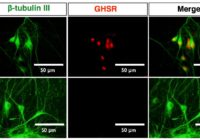How combining different G-protein-coupled receptors expands functionality, and provides new drug targets

Switched on by coffee? Rafael Franco and colleagues introduce the receptors responsible as members of a huge and diverse family of proteins – G-protein-coupled receptors – that are targeted by many of the drugs in our pharmacies. Their latest findings show how different adenosine receptor subtypes combine to act as a concentration-sensing device, highlighting how novel properties can emerge from different combinations of G-protein coupled receptors, and the potential for targeting these with drugs.



